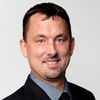Dr. Jan Sikorsky helps to build Envision programs to be the most effective for getting a true career experience. Here he answers questions about how we build our programs and the reasons behind them.
What is your role at Envision?
I’m the vice president of product planning and development here at Envision. Essentially, what I’m responsible for is ensuring there is realism and relevance in all of our product models.
How do you develop Envision’s immersive programs?
In terms of developing our programs, we really build our models to expose students to a career area they’re interested in, in a way that engages them in that field. An example in my field would be crime scene investigation and forensics. We build a mock crime scene and allow student teams to explore it like a scene investigator would, teaching them the techniques, but also the realism, behind it. It’s not what you see on TV; it’s actually what practitioners are doing in those fields. And, this really applies to all of our immersive programming.
How does Envision use emerging technologies in their programs?
One of the areas we’re very intrigued by in immersion programs is how we can incorporate new technologies into our models. An example of that would be augmented reality or virtual reality (VR). We’ve taken the time to not only build the setting for one our of medical programs in the VR space, but we’ve also complemented that with physical programming. Students go into a virtual operating room (OR) to conduct a procedure and experience the sights and sounds of what an OR would be like. Then, they actually have a simulated patient arm that they’re doing the same type of procedure on to get both hands-on experience in the physical space and the technical experience within the virtual space.
How do you use research when creating programs?
Another area I’m in charge of at Envision is our budding academic research arm. We are really utilizing data, not only to shape how we think about programming, but also where we want to make our investments and ensure our programs are successful in future years. One example is to really launch competency-based assessments in a number of our models. Not just telling a student how to suture in a medical situation, but showing them and engaging their competency ahead of that experience and then after instruction. We’re really investing a lot of time into not just what we do, but how we do it as well as testing to ensure what we’re building for students is effective and impactful.
Why do you enjoy working with Envision?
I’m often asked the question, “Why do you do what you do?” I have a background in bio-medical research and forensic science and I teach at the post-secondary level in forensic biology. So, why am I building career immersion programs for middle and high school students? I’ve spent the last 14 years building these programs. This is my career now. For me, it’s about what value these programs provide to our students--it’s really an investment in their future. I have students who have gone through some of our programs and are now faculty members at post-secondary institutions. This doesn’t just tell me how old I am, it’s also very rewarding to see individuals coming through a program, having a set of expectations, and allowing our models to shape how they view a specific career area. This then gives them the permission to either engage in that area or figure out a different thing to do with their lives, at a time when they can do something about it. It’s a truly rewarding experience to help students along their career pathway.
background-image: a building with the American flag in front of it

Jan Sikorsky, Ph.D., M.S.
Holding a Ph.D. in Biomedical Sciences and having served on the National Science Teachers Association Committee on College Science Teaching, Dr. Sikorsky is responsible for the science and skills development programs, where under his leadership, Envision’s product offerings have hosted more than 100,000 students.
MORE FROM AUTHOR
|
ADDITIONAL AUTHORS